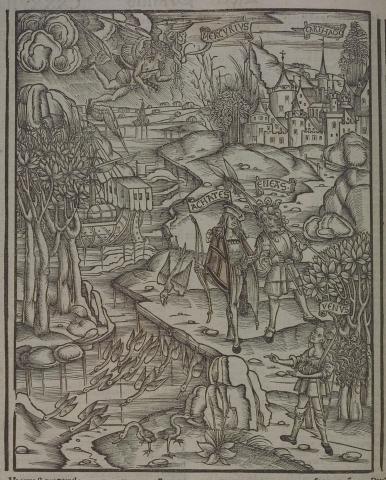Annotations
Mercury flies toward Carthage to alert Queen Dido of the presence of Aeneas near her city (297-304). The city is walled, at least partially, as described in lines 365-6. Below Mercury and the city, Aeneas has hidden his ship in a harbor surrounded by groves (310-2) and is now setting out to explore the place where he has landed, accompanied by Achates (306-9, 312). He carries two spears (313). Aeneas and Achates encounter Venus disguised as a Spartan virgin huntress (314-20): she carries a hunting bow on her shoulder, ties back flowing long hair, and bares her knees like a follower of Diana (318-20). In lines 321-440, Venus and Aeneas have a long conversation in which Venus informs her son that he has landed in Tyrian territory, ruled by Queen Dido, whose story she gives in some detail (335-370). Then, after hearing her son's story, in which he worries that he is doomed to wander forever (372-385), she assures him that he will settle down someday (387-401). In the image, she gestures to twelve swans, pursued by an eagle of Jupiter, which represent the ships of Aeneas scattered but all destined to survive (393-401). (Katy Purington)
Woodcut illustration from the “Strasbourg Vergil,” edited by Sebastian Brant: Publii Virgilii Maronis Opera cum quinque vulgatis commentariis expolitissimisque figuris atque imaginibus nuper per Sebastianum Brant superadditis (Strasbourg: Johannis Grieninger, 1502), fol. 137v, executed by an anonymous engraver under the direction of Brant.


Sebastian Brant (1458–1521) was a humanist scholar of many competencies. Trained in classics and law at the University of Basel, Brant later lectured in jurisprudence there and practiced law in his native city of Strasbourg. While his satirical poem Das Narrenschiff won him considerable standing as a writer, his role in the transmission of Virgil to the Renaissance was at least as important. In 1502 he and Strasbourg printer Johannes Grüninger produced a major edition of Virgil’s works, along with Donatus’ Life and the commentaries of Servius, Landino, and Calderini, with more than two hundred woodcut illustrations (Annabel Patterson).
Brant's conventional image of the walled city, in combination with the ships moored by the shore, provides a factual location for the meeting (fig. 13). Emphasis is on promises of Aeneas's future safety, of which the reader knows far more than the hero himself. Above the city appears the figure of Mercury, whom Jupiter has dispatched to create a hospitable welcome for Aeneas in an enemy land. In the foreground is the sign that Venus invokes to raise the spirits of her son: fourteen swans escaping pursuit by an eagle and settling safely on the earth (Eleanor Winsor Leach).